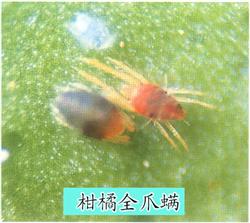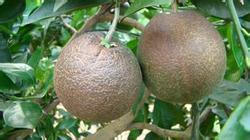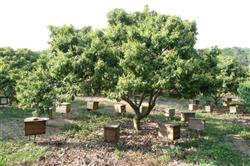Key points of citrus cultivation in January

January (Lesser Cold ~ Greater Cold) dormancy period, flower bud differentiation period from January to February is the coldest period of the year. Citrus, as an evergreen fruit tree, has the possibility of freezing injury from time to time in our province. This winter, the orange area of our province is generally faced with the problem of serious lack of precipitation, high-yield years, harvest delays, coupled with winter drought, once hit by the cold wave, it will cause serious freezing damage. A cold spell at the end of December has caused freezing damage in some orange orchards. Do a good job in winter management and improve citrus production next year. The main results are as follows: (1) Anti-freezing countermeasures January is the high incidence season of citrus frost injury. The freezing injury of citrus is caused by the injury or death of vegetative and reproductive organs caused by low temperature. The factors affecting freezing injury are citrus varieties (lines), rootstocks, plant growth, diseases and insect pests, low temperature intensity, low temperature duration, weather, wind speed, topography and so on. After freezing, the germination of orange trees was delayed in spring, the number of leaves decreased obviously, the growth of spring shoots was less, the shoots were short and thin, the physiological fruit drop period was prolonged, and the fruit setting rate decreased. Leaves are not only the storage place of nutrients, but also an important assimilation organ before the new leaves grow into synthetic photosynthates in the coming year. Preventing leaves from falling in winter is an important measure to maintain tree potential. The main measures of citrus freezing injury are: whitening the branches and stems of ①. The white coating evenly spreads the trunk branches, which is not only insecticidal and sterilized, but also anti-freezing and sunburn. The formula can be selected as follows: 0.5 kg of quicklime, 0.1 kg of sulfur powder, 3-4 kg of water, and about 20 grams of salt. ② is covered with soil. Cultivate into turf soil, pond mud, soil fertilizer, etc., thicken the soil layer, protect the roots against cold, and grow 20 to 30 centimeters high. The ground is covered with straw or other crop straw to cover the tree plate or the whole garden, with a thickness of more than 10 cm. For young trees, nurseries, etc., grass curtains, woven bags, film anti-freezing sheds and wind barriers can be used to cover and keep warm. ③ dry orange orchard, before the cold wave, use 0.3% 0.5% urea water plus 0.3% potassium dihydrogen phosphate topdressing for 1 or 2 times. ④ pays attention to watch and listen to the weather forecast, smoke when the cold wave comes, set up 4-5 smoke stacks per mu of orange orchard, and light the smoke in the early morning of frost. When ⑤ encounters snow, strengthen inspection and shake snow in time to prevent snow from breaking branches. (2) Storage management ventilation storage should keep the doors and windows out of the light and keep the indoor temperature 5oC~20oC. 5oC~10oC is the most suitable, wide-skinned citrus 5 ℃ ~ 8 ℃, grapefruit and sweet orange 3 ℃ ~ 5 ℃, relative humidity 85% to 90%, and the temperature difference between day and night should be as small as possible. When the temperature is lower than 4oC, close the doors and windows, strengthen the indoor cold protection and keep warm, and carry out noon ventilation. When the relative humidity in the warehouse falls below 80%, it should be covered with plastic film to maintain moisturization. at the same time, it can be sprinkled on the ground or put water in the basin to improve the air humidity. If the humidity is too high, the floating skin will occur and the decay rate will increase, so ventilation should be strengthened. During storage, when the temperature is lower than 4oC, close the doors and windows, strengthen indoor cold protection and keep warm, and carry out noon ventilation. Check the decay of the fruit regularly, pick out the rotten fruit and deal with it. If there is not much rot, try not to turn the fruit. (3) clear and open the garden to make use of winter leisure to clean the orange orchard, cut off the dead and diseased branches, cut the long and weak branches properly, eradicate weeds, sweep the fallen leaves and rotten fruit, brush the white tree trunk with lime, and seal the wormhole cracks on the tree trunk with oyster ash. The orange orchard that needs to be planted in the coming spring, dig the planting pier, hole, ditch. In coastal land and paddy citrus orchards, the groundwater level is relatively high, and it is suitable for pier cultivation. The shape of the pier is 2.0 m in lower diameter, 1.2 m in upper diameter and 0.8 m in height. 60 cm is maintained after sinking, and the bottom is covered with a 1.2 m diameter and 1.2 mm thick anti-root cloth, or cushioned with tiles to inhibit the downward extension of the main root. The newly reclaimed coastal land should add guest soil to build piers, and the coastal land that has planted pioneer crops to improve the soil should first use the surface soil as the core soil for building piers, and the raw soil should be built on the surface of the piers. The planting ditch is dug according to the depth and width of 80cm and 100cm respectively. According to the requirement of row spacing, the bottom of the pier is dug to a depth of 30 cm, and the base fertilizer is filled in the bottom of the pier or in the planting ditch, and 25 tons of organic fertilizer or green manure is applied per hectare.
- Prev

Measures to control citrus rust wall lice
Pay attention to the inspection of citrus plants, when there is a rapidly expanding layer of yellowish gray on the leaves and fruit surface, and when there are individual black fruits on citrus plants, or with a 10-fold magnifying glass, it is found that there are 2 and 3 rust wall lice in each field of vision, it is necessary to prevent and cure them in time. You can choose MMel 45 Dasheng 600 times solution, or 25% triazotin 1.
- Next

Management of litchi in spring is the key.
From September last year to January this year, the weather continued to be warm and dry, dry and less rainy, which promoted the nutrition accumulation and flower bud differentiation of litchi and longan. Due to different varieties of litchi, the tree condition was quite different. Corresponding measures should be taken to manage the specific conditions: (1) applying strong flower fertilizer: after the flower ear is formed.
Related
- Moge, come on! The staff of the peasant association in the producing area of cantaloupe were frightened when the crowd gathered.
- Causes and Solutions of low Fruit setting rate of Apple
- Symptoms and control measures of passion fruit virus disease
- Fruit growing lesson: how do apple orchards keep high yields?
- Can you build orchards in the mountains? What are the pros and cons?
- How to manage the coloring period of Crisson grape?
- This paper introduces the processing technology of two kinds of fig products.
- How much is a month for retired teachers in rural areas by 2020?
- How can strawberry planting increase sugar content? We should pay attention to management in many aspects.
- What are the cultivation techniques on how to improve the yield of golden fruit?

